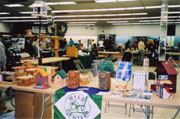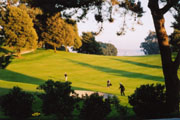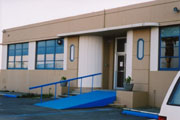|
|
Checkin’ Out Vallejo’s San Francisco Bay Flyway Festival
Up Close and Personal with the Birds and Untapped Natural Beauty on Mare Island
By Nancy Salcedo
 |
| Mare Island wetlands |
Combining an opportunity to
explore Vallejo’s otherwise off-limits Mare Island with the
only birding and migration festival held on the Bay, the annual San Francisco Bay Flyway Festival is “must-do” entertainment for Martin Luther King weekend each year. This year was no exception, the weather was perfect, the birds were out, and its a chance to get on Mare Island, part of a “Globally Important Bird Area” and a recently designated a National Historic Landmark. For hikers and birders, the festival provides miles of guided walks throughout the region. If you’re looking for the latest on the bayshore’s current land use and restoration issues, this is the place: Festival regulars include Save the Bay, Ducks Unlimited, Inc., Point Reyes Bird Observatory, San Francisco Bay Bird Observatory, all the local Audobon and Sierra Club chapters, Bay Area Ridge Trail Council, U.S. Fish and Wildlife Service, project managers from Lennar Mare Island-(Mare Island’s Master Developer) and of course, festival founder and coordinator Myrna Hayes herself. Indeed, discussions regarding the region’s abundant natural resources, Mare Island’s future, and other issues facing bay wetlands fill many a guided walk.
 |
Inside the festival there are several opportunities for children to build, draw and create at the Naturalist’s Marketplace. There are also over 50 exhibits from nonprofit organizations that work to protect the bay, or its wildlife. You will be inspired to check out the live birds visiting from Lindsay Wildlife Museum and SixFlags Marine World, the Bay Area Wetlands to Ridgetops Fine Art Exhibition (where local artists present original artwork depicting local wildlife and landscapes), and browse among birding equipment and books. This year, volunteers from the
Napa-Solano Audobon Society and the California Department of Fish and Game provided building materials and assistance so children could construct and bring home birdhouses.
 |
The festival’s guided walks are a major draw. Bird sightings Saturday included horned larks, among others.The schedule of guided walks reads like an atlas of land use and wetlands restoration issues along the
bayshore: Skagg’s Island, Cullinan Ranch, Tolay Creek, Guadacanal Village Wetlands, Viansa Winery Wetland and Waterfowl Preserve, Elkhorn Canyon in Crockett, and Mare Island itself. Building 505 here is slated to become the
San Pablo Wildlife Discovery Center, a 21,000 square-foot, multi-agency environmental education and interpretive center, the only one of its kind in the North Bay. The building sits amidst more than 2200 acres of wetlands planned to be added to the San Pablo Bay National Wildlife Refuge. It is an incredible setting perched in the middle of the flyway. Nearby, Save the Bay offered guided canoe paddles along the Napa River. You could have also ventured to Petaluma to learn why Shollenberger Park is one of Sonoma County’s best kept secrets.
 |
| Loon, Frank Costa, Bay Area Wetlands to Ridgetops Fine Arts Exhibit |
Myrna Hayes founded the Flyway Festival on Mare Island “in hopes that it would be a catalyst for environmental awareness and natural resource stewardship.” The Flyway Festival is full of opportunities to explore the
bayshore, and Mare Island is clearly the ultimate, though for now, ellusive exploration opportunity.
 |
| The Mare Island Golf Course |
The chance to visit Mare Island, which is generally not accessible to the public, is indeed a joy. Mare Island, established in 1854, is the oldest naval installation in the Pacific, and is a National Historic Landmark with over 500 buildings eligible for the National Register of Historic Places. So far, 50 are listed on the Register, such as St. Peters Chapel, circa 1901, with its memorial stained glass panes signed by Tiffany Studio works. The chapel is located among extensive grounds with stately trees to which monarch butterflies migrate to spend the winter. Mare Island’s shipbuilding facilities served the Navy since the Civil War, when sailing vessels used whale oil for lighting, and evolved to produce coal-powered, diesel-powered, and later nuclear-powered ships. Much of the infrastructure from the ship building activities is visible from the Vallejo waterfront.
 |
| The Mare Island Golf Course |
On the San Pablo Bay side of the island is Building 505, home of the future San Pablo Bay Wildlife Discovery Center, an interesting reincarnation story itself. In its day, Mare Island was the hub of Pacific radio communications before and during both world wars. At first, pigeons were used by the navy as messengers between Mare Island and Yerba Buena Island. They were later replaced by the Radio Shack, the first wireless station on the Pacific Coast. Building 505 was built in 1940 to meet increasing demand for radio communications. It was through this facility that the mainland learned of the attack on Pearl Harbor in World War II. From this building, now quiet and standing alone in the marsh, you can view much of the island’s wetlands. It is also where several trails disembark into the
baylands.
 |
 |
Mare Island Waterfront
|
Mare Island, decommissioned in 1996, is in the process of being readied by the Navy for its public opening. It is an incredible place to visit under any circumstances and you should get there anyway you can. In addition to the Flyway Festival, which is held every year
(www.sfbayflywayfestival.com, or (707) 557-9816), access is also available through the Mare Island Historic Park Foundation
(www.willardsworld.com, or (707) 557-1538).
The Flyway Festival proved the successful catalyst it was meant to be: It lured me out to Mare Island, into the marsh, and made me aware of this great place and its abundant natural treasures. I’ll come back any chance I get, and look forward to the opening of building 505 as the San Pablo Bay Wildlife Discovery Center, and of Mare Island into a place the public can come and learn about the area’s maritine history, walk through the marshes, and explore the treasures of its lively past, and its promising future.
 |
| Building 505 |
|